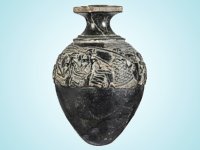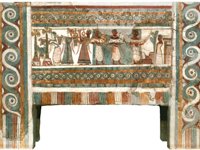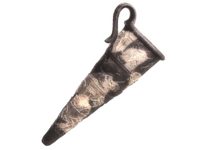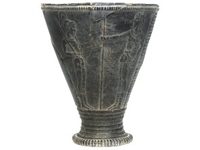The Harvesters' Vase

Religious feasts of an agricultural nature took place in the countryside, as depicted in the famous "Harvesters' vase from Agia Triada.
Here a group of farmers is presented with singular vitality as they return from the fields singing and holding winnowing fans. The procession is headed by an elderly man, clearly a priest as indicated by his characteristic garments, while a musician accompanies the the song and the procession with a sistrum or rattle.
An exceptional work with a dense, strong composition in a naturalistic style.
Neopalatial period (1500 - 1450 BC)
On display at Herakleion Museum
The Sarcophagus
It is the only stone sarcophagus ever to have been found in Crete. It is wholly covered in plaster and painted in fresco. It was found in a relatively unimportant tomb at Aghia Triada, but it is believed that it was originally used for the burial of a prince during the Mycenaean occupation of Crete.

The painted frieze around the sarcophagus shows all the stages of the sacred ceremony which was performed at the burial of important personages.
The dead person is depicted on one long side, in fron of his tomb, receiving offerings of a boat and two bulls, while libation are being poured between double axes to the accompaniment of a lyre. On the other long side we see the sacrifice of a bound bull set on a table - altar to the accompaniment of a flute; alongside are offerings in baskets near a shrine with a tree and a mast with a bird on top. On the two short sides there are figures on chariots drawn by wild goats and griffins, possibly suggesting the voyage of the distinguished dead person to the next world and his deification.
The scenes on the sarcophagus portray the ritual observance of the interment and funeral offerings and, at the same time, suggest the views of the Minoans on the after life.
Postpalatial period (1350 - 1300 BC)
On display at Herakleion Museum

The Boxers'Vase
A steatite vase with relief scenes of boxing and bull leaping in front of porticos with columns that are represented in four successive bands. The figures are depicted with power and realism, in stances and dress that are remniscent of modern boxing
Neopalatial period (1500 - 1450 BC)
On display at Herakleion Museum

The "Chieftain's Cup"
The stone "Chieftain's Cup" depicting an official or priest with along sceptre and a young man holding a sword.
Neoplatial period (1600- 1450 BC)
On display at Herakleion Museum